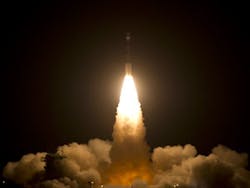Interferometer Plays Key Role Onboard New Satellite
Nov. 1, 2011
2 min read
Long used in various forms of manufacturing, particularly electronics, the interferometer is now playing a role in the first of a new generation of U.S. meteorological satellites. Launched from the Vandenberg Air Force Base aboard a Delta II rocket on October 28, 2011, the NPOESS (National Polar Orbiting Environmental Satellite System) will help NOAA (National Oceanic and Atmospheric Administration) scientists develop better severe weather forecasts days in advance of what is capable of being projected now.Sensors on the satellite will monitor global environmental conditions, collect and disseminate data related to weather, atmosphere, oceans, and land. This launch marks the first satellite mission to address the challenge of acquiring a range of land, ocean, and atmospheric measurements for Earth system science while simultaneously preparing to address operational requirements for weather forecasting.The interferometer was developed by ABB as part of a project with ITT to create the Cross-track Infrared Sounder (CrIS), one of the instruments aboard the NPOESS. Reportedly capable of producing 100 times higher spectral resolution than the sensors onboard the current generation of meteorological satellites, CrIS will produce high-resolution, three-dimensional temperature, pressure, and moisture profiles.The NPOESS mission is "very gratifying since it will benefit all mankind by enabling more accurate weather forecasting and faster predictions of natural disasters such as hurricanes or tornadoes," said Marc-André Soucy, Remote Sensing industry manager with ABB.
About the Author
David Greenfield, editor in chief
Editor in Chief
David Greenfield joined Automation World in June 2011. Bringing a wealth of industry knowledge and media experience to his position, David’s contributions can be found in AW’s print and online editions and custom projects. Earlier in his career, David was Editorial Director of Design News at UBM Electronics, and prior to joining UBM, he was Editorial Director of Control Engineering at Reed Business Information, where he also worked on Manufacturing Business Technology as Publisher.
Sign up for our eNewsletters
Get the latest news and updates

Leaders relevant to this article:
